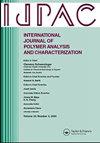Surface reactivity of polypropylene grafted with carboxylate groups (COO−) in the competitive adsorption of Pb2+, Cu2+, and Cd2+ in aqueous solution
IF 1.7
4区 工程技术
Q4 POLYMER SCIENCE
International Journal of Polymer Analysis and Characterization
Pub Date : 2025-03-01
DOI:10.1080/1023666X.2025.2470944
引用次数: 0
Abstract
In this study, we developed a new material (PPAAcO−Na+) charge with carboxylate groups to remove metal ions (Pb2+, Cd2+, and Cu2+) through ion exchange of multimetal solutions, (PPAAcO)nM2+. The polymeric surface of polypropylene (PP) was functionalized with carboxylate groups (PPAAcO−Na+) through grafting and the acid-base reaction of carboxylic acid (PPAA). FTIR-ATR corroborated the change of –COOH (1711 cm−1) to COO−Na+ (1562 cm−1) on functionalized PP. TGA-DSC showed a decrease in the melting energy of PPAA (75.09 J/g) and PPAAcO−Na+ (44.98 J/g). The effect of the grafting degree of COO− and its relationship with the concentration of acrylic acid (AA) was studied with grafting of 30%, 80%, and 154% on PPAAcO−Na+. SEM-EDS evidenced the relationship of the AA concentration, showing a thickening of the PPAAcO−Na+ fibers. The performance of PPAAcO−Na+ as a function of the grafting degree in the removal of Pb2+, Cd2+, and Cu2+, showed the following trend: Pb2+>Cd2+>Cu2+, achieving an efficiency greater than 90%. The fast adsorption of the metallic ions (120 min) suggests an ion exchange process, promoting a chemical interaction between PPAAcO−Na+ and the metallic ions, resulting in a polymer-metal complex (PPAAcO)nM2+. PPAAcO−Na+ has the potential to be a new, easily obtained material capable of coordinating and stabilizing metal ions on its surface.
羧酸基接枝聚丙烯(COO−)在水溶液中竞争吸附Pb2+、Cu2+和Cd2+时的表面反应性
在这项研究中,我们开发了一种新的材料(PPAAcO - Na+),带羧酸基,通过多金属溶液的离子交换去除金属离子(Pb2+, Cd2+, Cu2+), (PPAAcO)nM2+。通过接枝和羧酸(PPAA)的酸碱反应,聚丙烯(PP)的聚合物表面被羧酸基团(PPAAcO−Na+)功能化。FTIR-ATR证实了功能化PP上-COOH (1711 cm−1)变为COO−Na+ (1562 cm−1)的变化,TGA-DSC显示PPAA和PPAAcO−Na+ (44.98 J/g)的熔化能降低。在PPAAcO−Na+接枝率为30%、80%和154%的情况下,研究了COO−接枝度对PPAAcO−Na+的影响及其与丙烯酸(AA)浓度的关系。SEM-EDS证实了AA浓度的关系,显示PPAAcO−Na+纤维增厚。PPAAcO−Na+对Pb2+、Cd2+和Cu2+的去除率随接枝度的变化趋势为:Pb2+>;Cd2+>Cu2+,去除率均大于90%。金属离子的快速吸附(120 min)表明,离子交换过程促进了PPAAcO−Na+与金属离子之间的化学相互作用,从而产生聚合物-金属配合物(PPAAcO)nM2+。PPAAcO−Na+有潜力成为一种易于获得的新型材料,能够在其表面配位和稳定金属离子。
本文章由计算机程序翻译,如有差异,请以英文原文为准。
求助全文
约1分钟内获得全文
求助全文
来源期刊
CiteScore
3.50
自引率
5.30%
发文量
37
审稿时长
1.6 months
期刊介绍:
The scope of the journal is to publish original contributions and reviews on studies, methodologies, instrumentation, and applications involving the analysis and characterization of polymers and polymeric-based materials, including synthetic polymers, blends, composites, fibers, coatings, supramolecular structures, polysaccharides, and biopolymers. The Journal will accept papers and review articles on the following topics and research areas involving fundamental and applied studies of polymer analysis and characterization:
Characterization and analysis of new and existing polymers and polymeric-based materials.
Design and evaluation of analytical instrumentation and physical testing equipment.
Determination of molecular weight, size, conformation, branching, cross-linking, chemical structure, and sequence distribution.
Using separation, spectroscopic, and scattering techniques.
Surface characterization of polymeric materials.
Measurement of solution and bulk properties and behavior of polymers.
Studies involving structure-property-processing relationships, and polymer aging.
Analysis of oligomeric materials.
Analysis of polymer additives and decomposition products.

 求助内容:
求助内容: 应助结果提醒方式:
应助结果提醒方式:


